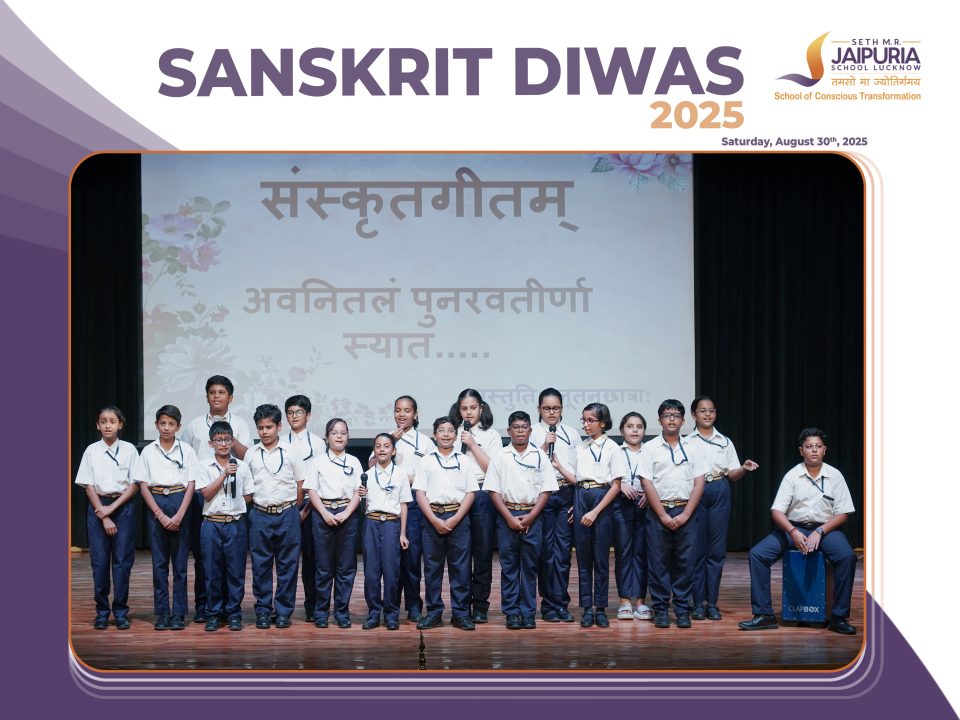
Day 1: Spiritual Retreat – Edition 8 | Immersing in the Eternal Wisdom of the Vedas | Seth M.R. Jaipuria School
May 29, 2025
ICSE Felicitation Ceremony – Batch 2024–25 | Honouring 154 High-Achievers with 90% and above scores
June 5, 2025Sri Aurobindo’s words echoed throughout the walls of Jaipuria school: “The Upanishads are the divine poetry of consciousness.”
The second day of the retreat began with Hatha Yoga, where students engaged in various practices that energised their bodies, preparing them for a day immersed in the eternal knowledge of the Upanishads.
After a meditative and silent breakfast, students walked to the school temple. Glistening under the soft rays of the sun, they entered the temple, which houses the relics of Sri Aurobindo, along with the Charan Padukas of The Mother and other sacred artefacts. Students sat down and meditated in the divine presence of Sri Aurobindo and The Mother.
Returning to the school auditorium, students settled in for the first session of the day: “Understanding the Upanishads: The Quest for Truth.” The session was delivered by Prof. Sampadananda Mishra, Dean of Culture and Director of the Centre for Human Sciences at Rishihood University.
The day opened with a compelling discourse by Prof. Mishra, who began by emphasising that the Upanishads are not merely ancient texts but living documents that contain the highest truths of existence. They are known as Vedanta, meaning “the culmination of the Vedas,” and are regarded as Rahasya Vidya, or secret knowledge that unveils the essence of life and the universe.
Prof. Mishra explained that the core pursuit of the Upanishads is Self-realisation—the ultimate understanding of our true nature. One of the fundamental questions they pose is “Who am I?”—a question that points inward rather than outward. This self-inquiry reveals that within us lies a divine spark, often described as a tiny flame in the heart’s centre: “Angusthamatra purusha madhya atmani tishthati,” meaning “the soul, the size of a thumb, resides steadily at the centre of the heart.”
He described the soul as “a smokeless, steady flame”—radiating purity and constancy. The ultimate purpose, he said, is to realise this divine presence within and to understand that “the Self is one with the Supreme”—an undivided reality. This realisation, according to the Upanishads, is the key to moksha (liberation) and joy beyond worldly pleasures.
Prof. Mishra underscored the importance of a disciplined approach—“Turning inward with sincerity is the only way.” He explained that reflection, meditation, study, and devotion create a living connection with the divine knowledge embedded in these texts. The Upanishads, he said, “are the poetry of consciousness”—a divine influx that reveals the bliss and unity underlying all existence.
Reflections and Q&A: Deepening the Inner Quest
Following the foundational discourse, a lively question-and-answer session ensued, where participants shared their doubts and insights. One participant asked how a beginner might relate to the profound teachings of the Upanishads. Prof. Mishra advised: “Start with the basics—understand the parts about the Self and the divine presence. Take notes, reflect, and gradually integrate this knowledge into your daily life.” He emphasised, “The ultimate message is simple: realise the divine within, and live in harmony with it.”
Another participant asked, “In this material world, how do we strike a balance between material progress and spiritual growth?” Prof. Mishra referred to the Isha Vasyam mantra: “Isha Vasya Midam Sarvam Yatkincha Jagatyam Jagat,” meaning “the Divine pervades everything.” He explained that material objects are divine but should not lead to attachment. The key is to enjoy worldly possessions without losing sight of divine consciousness—“Use them as means, not ends.”
The session also revisited the story of Vedavyasa, who, even after compiling the Vedas, felt unfulfilled. Narada appeared and advised him, “Write the story of Krishna,” which led to the creation of the Shrimad Bhagavatam and, eventually, the experience of genuine joy. These stories illustrated that “persistent seeking, guided by divine wisdom, is what ultimately leads to fulfilment.”
Prof. Mishra emphasised that the “divine connection is not separate from ourselves—it is always within, waiting to be awakened through sincere effort and love.” Quoting Sri Aurobindo, he said, “Turn to the Upanishads to experience the finest poetry,” reminding us of their poetic and mystical richness.
Rangoli and Flower Arrangement: Symbols of Divine Beauty in Nature
In the afternoon, students participated in a creative session inspired by Upanishadic symbols and the spiritual significance of flowers, led by Chitra Badhe, who had flown in from Puducherry. She explained how flowers are gifts from nature that symbolise divine qualities—“Their symmetry reflects balance, their fragrance signifies purity, and their growth exemplifies beauty.”
Chitra highlighted that flowers are not merely aesthetic objects but carriers of divine energy and sacred messages. Each flower holds a unique spiritual significance revealed through deep contemplation. She shared that The Mother had assigned spiritual meanings to over 800 flowers, transforming them into a language of sadhana (spiritual practice).
For instance, she explained that the marigold symbolises “plasticity,” or adaptability, while the hibiscus stands for “dynamism,” representing active growth. Each flower’s vibrational essence conveys a message—be it purity, humility, strength, or resilience—that practitioners can reflect upon in their spiritual journey.
Students then engaged in a hands-on activity, arranging flowers in the shape of ‘Om’ in various scripts and dialects. Through this artistic expression, they reflected on the symbolic meanings of the flowers—qualities such as humility, devotion, love, and purity. The gentle act of placing each bloom became a silent meditation, reinforcing that offering a flower is more than a ritual—it is an act of inner worship, surrender, and prayer.
Chitra encouraged students to “be like a flower,” cultivating qualities that uplift the soul. The activity itself became a meditative practice—a way to align with the divine qualities embodied in nature and foster a deeper connection with the presence inherent in all things.
Session on Atma Puja: Worshipping the Divine Within
The day concluded with a special session by Prof. Mishra on Atma Puja—the internal worship of the Self. He explained that true worship begins within: “The divine resides in each of us, like a steady, smokeless flame in the heart.” The practice of Atma Puja involves consciously recognising this inner divinity, transforming external rituals into personal, inner realisation.
He said, “Every flower, every act, is an offering to the divine that already exists inside us.” Drawing from the Upanishads, he reiterated that the Self is divine and eternal, and by practising internal worship, we align with this truth and cultivate peace, love, and self-awareness.
Students were guided to visualise the divine fire at the centre of their hearts, perceiving it as a steady flame that illuminates the path to inner bliss. Prof. Mishra quoted Sri Aurobindo: “The Upanishads are divine poetry that reveal the highest bliss when experienced,” reinforcing that the realisation of our inner divinity is the truest form of worship.
He concluded by encouraging everyone to “Make it a daily ritual to recognise and honour the divine within—this is the true essence of Atma Puja.” External offerings, then, become symbolic of inner awareness, leading to transcendence and joy.
This day beautifully illustrated that the spiritual journey involves both understanding the deep truths of the Upanishads and expressing them through symbolic acts like flowers. As Prof. Mishra summarised: “The Upanishads teach us that the divine is within you; the flowers remind us of beauty, purity, and devotion.”





































